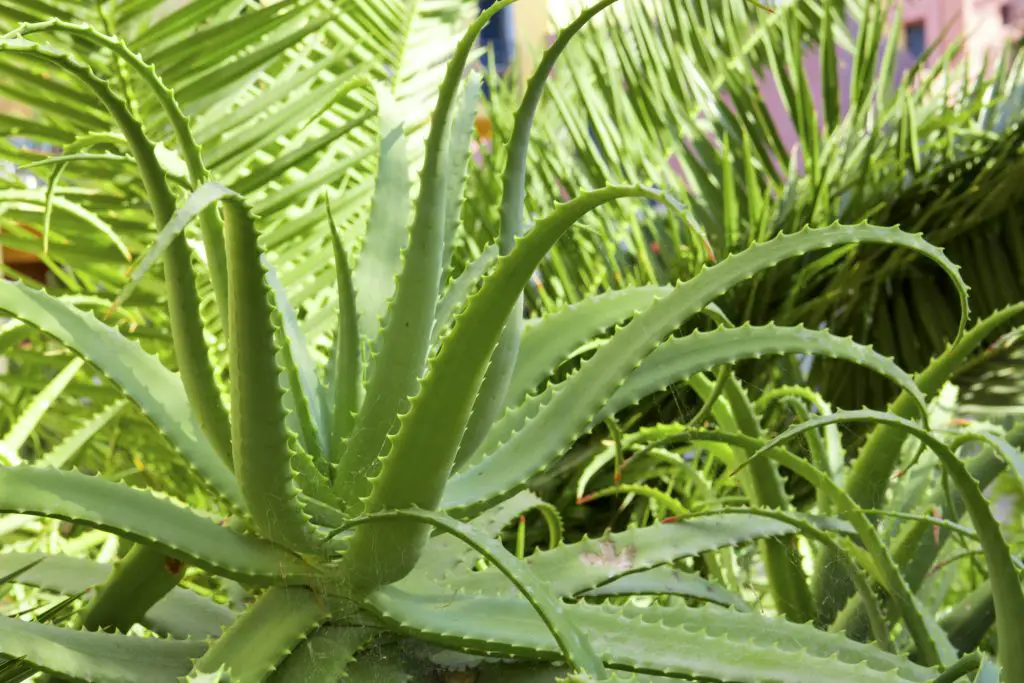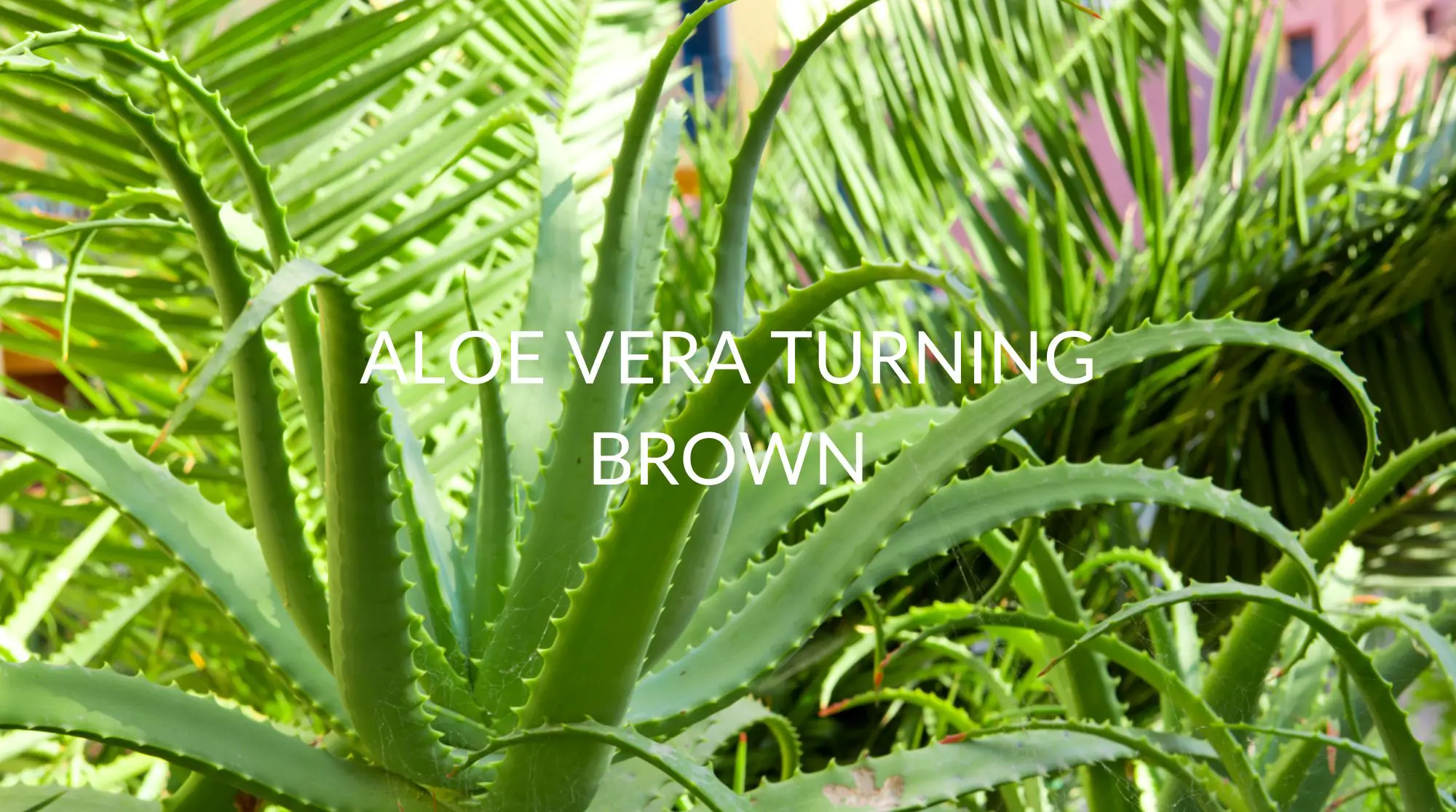The most common reason for an Aloe to develop brown leaves is overwatering. Aloe only needs water every 2-4 weeks, or even less in the winter months. Other causes include poor soil conditions, low light, pests and disease, cold temperatures, or over-fertilizing.
If your Aloe Vera leaves are turning brown or developing brown spots, or even mushy spots, this is a sign your Aloe is in distress. The first thing to do is to figure out what in your plant’s environment needs to change.
Some leaves will turn brown and fall off naturally, but if you notice that the number of brown leaves is increasing, or you notice that your Aloe’s roots are damaged, you will need to remedy the problem as soon as possible.
Brown leaves can be fixed, though you will have to be patient and give the plant some time to adjust to its new environment.
Don’t delay if you start to see brown spots on your aloe leaves. Consider the issues listed below to figure out what may be plaguing your plant.
What Does It Mean When Your Aloe Vera Plant Turns Brown?
Aloe is typically a hearty plant that grows in a variety of conditions fairly well. If something is going wrong, it’s just your plant telling you it needs some attention.
Overwatering
By far, the most common reason for problems with Aloe Vera is overwatering. Aloe is a succulent that retains water for very long periods, which means it is designed to thrive in a very dry desert-like environment.
When overwatered, the roots cannot dry out enough to stay healthy, and they begin to rot. When root rot begins, the plant becomes less able to absorb water and nutrients, and the leaves turn brown.
It may be tempting to just water your Aloe along with your other houseplants, but in fact, it needs a completely different treatment.
Underwatering
Underwatering an Aloe isn’t a very common problem since they thrive with so little water, though they do need some water to retain their plump green leaves. Underwatering is more of a problem in the summer growing season when Aloe will need to be watered more frequently.
If your Aloe is developing dry brown tips, or the leaves look puckered, wrinkled, or wilted, you will need to water. If it is bone dry, soak it completely until water runs out of the drainage holes. Do this a few times until the soil is soaked, then let it sit and drain.
If the soil is completely dry, water it immediately.
Poor Drainage
Even if you are not overwatering your Aloe, it may be developing brown spots because it is sitting in damp soil due to poor drainage. If your pot doesn’t have at least one drainage hole in the bottom, it is not suitable for Aloe.
Likewise, never leave your Aloe sitting in a dish of water. Other plants can be watered from the bottom, but leaving Aloe in a dish of water will kill the roots.
Aloe needs to grow in sandy soil with lots of inorganic matter like sand, rock, or perlite. Not regular potting soil, which retains too much moisture.

Over Fertilizing
Aloe is a hearty plant, though it is sensitive to harsh chemicals in its environment. Aloe does well with a small amount of liquid fertilizer monthly or less (though it also grows well without it). You want to be careful not to over-fertilize.
Only fertilize in the summer growing season. If you notice that the soil has salt deposits on top, this may be from over-fertilizing. You will need to flush the salt out of the soil or repot your plant with fresh soil. (Make sure you use succulent or cactus soil.)
Aloe leaves can also “burn” if they are exposed to chemicals, like cleaning products, pesticides, herbicides, and fungicides.
Low Light
Aloe grows in a wide range of conditions, though it likes bright light for much of the day. If your Aloe is in a north or east-facing window, it may not be getting enough light. This will interfere with the plant’s ability to thrive, which may be indicated by browning leaves on your Aloe.
Cold Temperatures
Aloe is happiest in temperatures between 55 and 85 ℉ (around 13-30℃). If your Aloe is left outdoors when the temperature is dipping below that range, it may begin to develop brown patches or leaves.
Why Is My Aloe Vera Turning Brown After Repotting?
Stress or Shock
Aloe is a hearty plant, but even the heartiest cannot tolerate a large amount of stress. If you have recently moved your plant to new conditions, your Aloe brown spots might be due to shock or stress.
Make sure your Aloe is getting the right amount of water, and keep it out of the direct sun. It may just need to rest and get used to its new conditions.
If the problem doesn’t resolve in a week or so, you may want to consider the following additional factors.
Poor Soil
If you have changed the type of soil in your Aloe pot, it may take the plant a little while to get used to it. Aloe should always be grown in succulent or cactus soil that is very sandy and has good aeration and drainage.
If you have repotted your plant in regular potting soil, this will suffocate the roots. If you only have potting soil, you will need to make your own succulent soil by mixing in coarse materials like pumice, perlite, coarse sand, or gravel. See below for making succulent soil.
Keep in mind if you have repotted your Aloe in new soil, you will have to monitor it for a while to determine its new water needs. The new soil may retain more or less water than the prior soil–so you may be overwatering without realizing it if you are watering on a schedule.
Make sure you do the soil test and continue to only water when the soil is three-quarters dry.
Inadequate Pot
Does your new pot have at least one drainage hole? Some pots are beautiful but terrible for plants because they have no drainage.
Your pot also needs to be deep enough that the roots of your plant are not compacted into the bottom of the pot. If you had to scrunch up your plant to repot it, your pot is too small. If you can, you may want to separate any Aloe “pups” off the original root system and grow them in their own pots.
Root Damage
When you repot your Aloe, it’s a good idea to shake off all the excess soil and inspect the roots before placing them in your new pot. If you notice any roots that are brown, black, mushy, or smell unpleasant, they are rotten and should be trimmed off with clean scissors or shears.
Roots are healthy when they are white, dry, and supple. Be gentle when repotting, and don’t cut away too much root mass, or you may end up with browning leaves.
Inadequate Light
After repotting, did you place your Aloe in a new location? It may be adjusting to a different amount of light. If you moved your Aloe to a place with less bright light, that might be what is causing your brown leaves. Try putting it closer to the window, or outdoors if possible, though keep out of very hot intense sun.
Temperature
As with light, if you moved your Aloe to a new location, it may be too hot (or sunburned) or too cold. If your plant is near a heating or cooling source, like an air conditioner, fan, drafty window, or heater, it may be in the wrong temperature conditions.
What to Do When Your Aloe Vera Plant Turns Brown
If you begin to notice brown spots on your Aloe, don’t panic. Aloe is generally a hearty plant, and if you can take the time to figure out which of these problems are responsible for your brown leaves, you can fix the problem and get your plant healthy again.
Remove the Brown Leaves
If you can, gently trim away any fully brown leaves. You may be able to separate them easily from the rest of the plant. Trim away any mushy leaves as well.
Let Your Roots Dry Out
If your soil is very damp, remove your plant from the pot and let it sit for a few days to give the roots and soil some time to dry out. If your plant is growing in full sun for part of the day, you will want to keep the exposed roots in the shade to protect them during this time.
When the soil and roots are dry, and the roots look white and healthy, then you can repot your plant. It’s a good idea to add some fresh soil, if possible.
Trim Dead Roots
You will need to remove your plant from the pot and inspect the roots. If you see mushy brown or black spots, or you notice that your roots have an odor, those roots are lost to root rot and will need to be trimmed away.
If the entire root mass, or a significant portion of it, is rotted, it may be difficult to save the plant. In this case, try to separate any healthy roots from the dead ones or cut away any healthy part of the stem. You can propagate Aloe into new plants if you have some root mass (or, in some cases, from leaves).
Repot in Succulent Soil
If you are having problems with drainage, you should consider repotting the plant in soil that is at least half inorganic material like pebbles, sand, or perlite. Cactus or succulent soil is good for Aloe.
You can make your own soil by mixing roughly three parts potting soil, 2-3 parts coarse sand or gravel, and 1 part pumice or perlite. Many gardeners like to make their own soil so they can control how much drainage and aeration it has. Many also find it to be more cost-effective than buying pre-mixed cactus or succulent soil.
It probably isn’t a good idea to buy soil that comes with fertilizer mixed in, just in case, your Aloe is very sensitive to fertilizer. Better to add liquid fertilizer to regular soil as needed.
Move to Bright Light
If you have tried all the other suggestions, you may want to try to move your Aloe to a brighter spot or outdoors if possible.
Keep in mind that Aloe can get sunburned in very intense sun for many hours. Bright, indirect light is the best for as much of the day as possible.
If you have only low light, you may want to consider getting a grow light. Many succulents do well with indoor grow lights. You probably only need an LED or fluorescent light, and they come in a variety of sizes.
How to Prevent Browning of Aloe Vera Plant?
Don’t Overwater
The rule with most succulents is to let the soil dry almost completely before watering. You can check the soil with your finger or a chopstick to see if it is damp three-quarters of the way down to the bottom.
When in doubt, wait another few days to water. It may be difficult to leave your beloved Aloe alone for this long, but don’t worry! It is perfectly happy when watered, even as infrequently as once a month or less.
In the summer, you will probably need to water every 2-4 weeks, depending on how much light the plant gets and how dry your climate is.
In winter, you will water even less, probably not more than once a month.
Use Cactus or Succulent Soil
If you haven’t repotted your Aloe since you got it, and it came growing in the soil already, it’s hard to know whether it was planted in suitable soil or not. Many plants that come from big box stores may be sold in soil that is good for shipping but not good for the plant itself.
You can remove your plant and check the soil–if it is crumbly, sandy, and grainy, it is probably decent for succulents. If your soil looks like compacted topsoil or dirt, it is probably just potting soil, and you should repot your Aloe in better soil.
If you water your plant and notice that the water is just flowing around the soil mass and not soaking into it, you should probably repot your plant as well. Keep in mind if you haven’t watered your Aloe in a while, the soil may take a few soakings to loosen up and let water flow through.
Fertilize in the Summer Growing Season
Aloe that is grown in healthy conditions doesn’t tend to develop brown leaves. One way to keep your Aloe healthy and growing is to give it some liquid fertilizer for houseplants in the summer.
Less is more when it comes to fertilizing succulents. Remember, they grow in desert soils that aren’t high in nutrients. For potted plants, you can use an over-the-counter liquid houseplant fertilizer, in the smallest amount, around once per month.
Repot or Separate Your Plant When It Grows Out of its Pot
Aloe is easy to propagate when it develops “baby” or “pup” plants. Plus, you will have even more Aloe plants to enjoy (and treat sunburns with!) if you start to separate your larger Aloe plants.
Try to retain the roots when separating baby Aloe. If you cut away part of the stem, let it heal over for a day to a week or until the wound is healed over. Then you can pot them in succulent soil (with good drainage, of course).
If your Aloe roots are outgrowing your pot, you will need to repot, so the roots are not compacted in the bottom of the pot.
Inspect your Aloe for Pests
If you notice mites, flies, gnats, or mealybugs on the leaves of your Aloe, you will need to clean them off with a paper towel with dish soap or rubbing alcohol. Pests are rare on Aloe, but you will want to treat them as soon as possible if they develop.
Can Brown Aloe Turn Green Again?
In many cases, brown Aloe can turn green again if the plant is otherwise healthy and only a small amount of the root mass is damaged. If you follow the recommendations here, you should be able to get your Aloe vibrant again.
For plants that have significant root damage, it may be more difficult to save the plant. If your Aloe has no roots left, you may want to cut the stems (use a very sharp, clean knife) and try to propagate new plants. If you can get a few plants, you increase your chances of one of them surviving.
Conclusion
If you have brown Aloe leaves, don’t worry. You may have to guess and check a little to figure out the cause, but once you do, a solution shouldn’t be too difficult.








